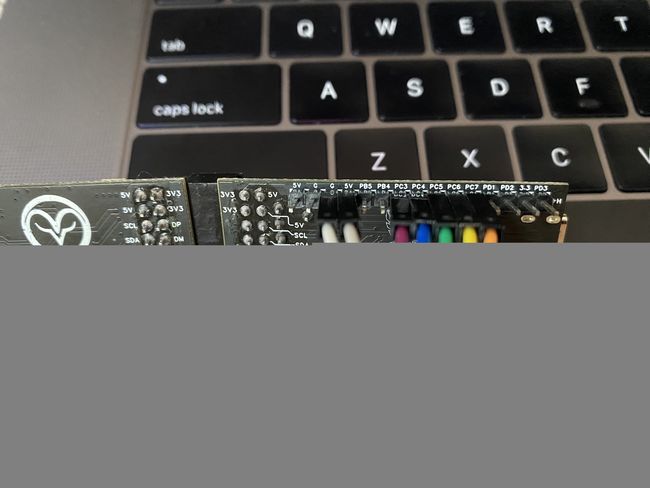让Pegasus天马座开发板用上OLED屏
继上篇《让Pegasus天马座开发板吃上STM8S标准库》移植完标准库之后,于是我又想为天马座开发板添加一块屏幕。终于在我的零件箱底下找到了沉入箱底多年的0.96OLED屏幕。
屏幕介绍
这个是128x64像素的屏幕模块,其使用的SSD1306的驱动IC。而目前该模组,只支持3/4线SPI及I2C通信方式。
硬件连接
我将天马座开发板通过4线SPI方式与OLED屏模组进行通信。板子与屏幕相关的连接如下代码所示
/****************时钟*********************/
#define OLED_SCL_PORT (GPIOC)
#define OLED_SCL_PINS (GPIO_PIN_3)
/****************数据*********************/
#define OLED_SDA_PORT (GPIOC)
#define OLED_SDA_PINS (GPIO_PIN_4)
/****************复位*********************/
#define OLED_RES_PORT (GPIOC)
#define OLED_RES_PINS (GPIO_PIN_5)
/****************数据/命令*********************/
#define OLED_DC_PORT (GPIOC)
#define OLED_DC_PINS (GPIO_PIN_6)
/****************片选*********************/
#define OLED_CS_PORT (GPIOC)
#define OLED_CS_PINS (GPIO_PIN_7)
接线图如下:
功能定义
我根据STM8S003P6及OLED硬件资源情况,主要定义了以下几个功能。
- 屏幕显示文字及数字
- 屏幕显示按钮的状态
- 通过按钮对屏幕显示参数进行配置
功能实现
OLED驱动移植
在购买OLED屏幕时候,卖家已经提供了该屏幕的SSD1306驱动。因此,只需将相关代码移植到Pegasus天马座开发板示例工程代码中即可。此处,移植过程不做介绍。如有需要的小伙伴,可参考我释放出来的工程代码,进行了解。
功能代码
实现功能定义的代码如下:
main.c
#include "config.h"
#include "delay.h"
#include "oled.h"
#define LED_GPIO_PORT GPIOD
#define LED_PIN GPIO_PIN_4
#define BUTTON_GPIO_PORT GPIOD
#define BUTTON_PIN GPIO_PIN_3
uint32_t count = 0;
#define TIM4_PERIOD 124
void tim4_isr() __interrupt(ITC_IRQ_TIM4_OVF)
{
static uint16_t ctr = 0;
if (++ctr >= 100) {
count++;
ctr = 0;
}
/* Cleat Interrupt Pending bit */
TIM4_ClearITPendingBit(TIM4_IT_UPDATE);
}
static void set_timer()
{
/* Time base configuration */
TIM4_TimeBaseInit(TIM4_PRESCALER_128, TIM4_PERIOD);
/* Clear TIM4 update flag */
TIM4_ClearFlag(TIM4_FLAG_UPDATE);
/* Enable update interrupt */
TIM4_ITConfig(TIM4_IT_UPDATE, ENABLE);
/* enable interrupts */
enableInterrupts();
/* Enable TIM4 */
TIM4_Cmd(ENABLE);
}
static void init_gpio()
{
GPIO_Init(LED_GPIO_PORT, LED_PIN, GPIO_MODE_OUT_PP_LOW_FAST);
GPIO_Init(BUTTON_GPIO_PORT, BUTTON_PIN, GPIO_MODE_IN_PU_NO_IT);
OLED_Init();
}
void set_screen_color_and_display(uint8_t cfg)
{
// BIT0作为屏幕颜色控制 0: 正常显示, 1: 反色显示
OLED_ColorTurn(cfg & 0x01);
// BIT1作为屏幕颜色控制 0: 正常显示 1: 屏幕翻转显示
OLED_DisplayTurn((cfg >> 1) & 0x01);
}
void main(void)
{
static uint8_t testBuffer[32] = {0};
static uint8_t k = 0;
bool isKeyDown = FALSE;
uint8_t screenCfg = 0;
uint8_t t = ' ';
disable_interrupts();
for (uint16_t i = 0; i < sizeof(testBuffer); i++)
{
testBuffer[i] = i;
}
enable_interrupts();
LOG("Startup...\r\n");
DUMP(testBuffer,sizeof(testBuffer));
init_gpio();
set_timer();
OLED_ColorTurn(0);//0正常显示,1 反色显示
OLED_DisplayTurn(0);//0正常显示 1 屏幕翻转显示
while (1)
{
GPIO_WriteReverse(LED_GPIO_PORT,LED_PIN);
isKeyDown = GPIO_ReadInputPin(BUTTON_GPIO_PORT,BUTTON_PIN) == RESET;
LOG(" app_sdcc == %u -- %lu, key %s\r\n",k++,count, isKeyDown ? "down" : "up");
if (isKeyDown == TRUE)
{
if (++screenCfg > 3)
{
screenCfg = 0;
}
set_screen_color_and_display(screenCfg);
OLED_Clear();
}
OLED_ShowString(25,0,"Pegasus Board",8);
OLED_ShowString(35,2,"2023/09/20",8);
OLED_ShowString(20,4,isKeyDown ? "Button Down" : "Button Up ",8);
OLED_ShowNum(103,4,k,3,8);
OLED_ShowString(0,6,"ASCII:",8);
OLED_ShowString(63,6,"CODE:",8);
OLED_ShowChar(48,6,t,8);
t++;
if(t>'~')t=' ';
OLED_ShowNum(103,6,t,3,8);
delay_ms(500);
}
}
#ifdef USE_FULL_ASSERT
/**
* @brief Reports the name of the source file and the source line number
* where the assert_param error has occurred.
* @param file: pointer to the source file name
* @param line: assert_param error line source number
* @retval None
*/
void assert_failed(uint8_t* file, uint32_t line)
{
/* User can add his own implementation to report the file name and line number,
ex: printf("Wrong parameters value: file %s on line %d\r\n", file, line) */
LOG("Wrong parameters value: file %s on line %d\r\n", file, line);
/* Infinite loop */
while (1)
{
}
}
#endif 运行效果
让Pegasus天马座开发板用上OLED屏
工程分享
工程下载路径



